A first-principles study on the properties of Sn-doped LiCoO2 for Li-ion batteries†
Abstract
The key for the application of LiCoO2 as a lithium-ion battery electrode at high voltage is to suppress the irreversible phase transformation from the layered to the spinel/rocksalt structure during cycling. The experimental study (R. Zhao, J. Zhang, G.-H. Lee, K. Zhang, V. W.-H. Lau, J.-J. Lee, I. Moudrakovski, Y.-L. Yang, F. Zou, M. Park, I. M. Hung and Y.-M. Kang, J. Mater. Chem. A, 2020, 8, 12424) demonstrated that Sn doping into LiCoO2 effectively inhibits the undesired phase transition and ascribed the structural stability to the ability of the Sn dopant to pin the lattice thermal vibration. However, the detailed information on Sn-doped LiCoO2, such as atomic structures, still remains uncovered. Here, we carried out a comprehensive theoretical study on un-doped and Sn-doped LiCoO2 with the aid of first-principles calculations. Our study shows that the un-doped and Sn-doped systems investigated in the experiment should contain Co–O vacancies and Sn prefers to be doped at the site that is near to the Co–O vacancies. The study also demonstrates that Sn-doping can significantly decrease the variation in volume and inhibit Co migration during delithiation. Additionally, Sn-doping can reduce the average activation barrier of Li diffusion. The theoretical study gives an insight into the microscopic mechanism of Sn-doping to enhance the performance of LiCoO2 as a cathode material and is a necessary complement to the experimental study.



 Please wait while we load your content...
Please wait while we load your content...